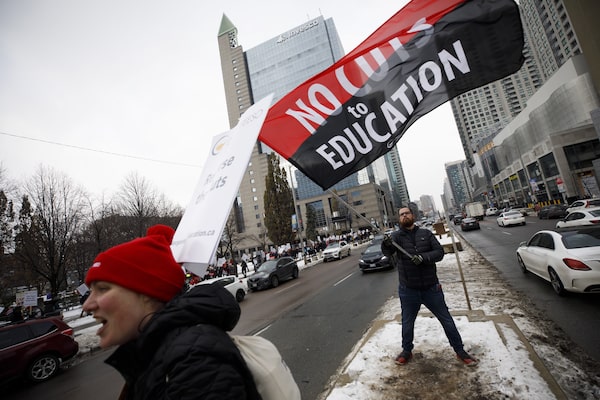
Members of the Ontario Secondary School Teachers Federation picket outside of the Toronto District School Board head office in Toronto on Dec. 4, 2019.Cole Burston/The Canadian Press
Ontario’s high-school teachers’ union has reached a tentative deal with the provincial government, ending months of job action. It was the last education union in the province to do so.
The Ontario Secondary School Teachers’ Federation (OSSTF), which represents 60,000 public high-school teachers and education workers, said on Monday that local leaders would review the deal in the coming days before member ratification votes tentatively planned for May.
“While this tentative agreement does not satisfy all of our concerns, we recognize the current environment we are in and the need for students to have stability once this emergency is over,” president Harvey Bischof said in a statement.
He added: “These are extraordinary times. When we began negotiations nearly a year ago, no one could have anticipated the situation we face today.”
Schools across the province are closed until at least May 4 in a bid to limit the spread of COVID-19, although Premier Doug Ford has indicated that the shutdown would be extended.
Details of OSSTF’s tentative deal were not immediately revealed, but a source said it was similar to one ratified earlier this month by the Catholic teachers’ union. That deal included one-per-cent annual salary increases, averages class sizes in high school of 23 students, up from the previous average of 22, and two mandatory online learning courses with an opt-out policy for families.
Education Minister Stephen Lecce said in a statement on Monday that the government’s goal was to ensure students “develop the skills they need to succeed in the classroom and in the jobs of the future.”
He also said that it was the government’s priority to reach “good deals” with education unions and “that is exactly what we have done by reaching deals with every education union in this province.”
Prior to schools being closed, all four of the main teachers’ unions had been engaged in job action as tensions with the government rose. The unions recently renewed talks with the government and school-trustees associations.
Last month, Mr. Lecce announced changes to the province’s proposals. Among them, he said his government made a commitment to maintain full-day kindergarten and fund supports for special education and other learning needs negotiated in a previous contract.
The government also softened its stance on increasing average class sizes in high school, reducing it to 23 for the length of the contract. Previously, the government had set a goal of 28 and then 25, which would have led to thousands of fewer teachers over four years.
The current average is 22.9.
Further, Mr. Lecce said parents could meet with school guidance counsellors to opt their children out of two online courses that are required to graduate from high school. The province had initially planned to have four online courses.
As part of the new offer, the government said it would require unions to comply with its wage-cap legislation, meant to limit public-sector pay increases to 1 per cent, and wants concessions on a seniority-based hiring regulation.
Teachers and education workers had been without a contract since the end of August.
The issues for the various unions included class-size increases in high school, mandatory online courses for high-school students, benefits and a hiring regulation that gives supply teachers with more seniority an edge in being chosen for long-term occasional and permanent teaching positions.
Our Morning Update and Evening Update newsletters are written by Globe editors, giving you a concise summary of the day’s most important headlines. Sign up today.
 Caroline Alphonso
Caroline Alphonso